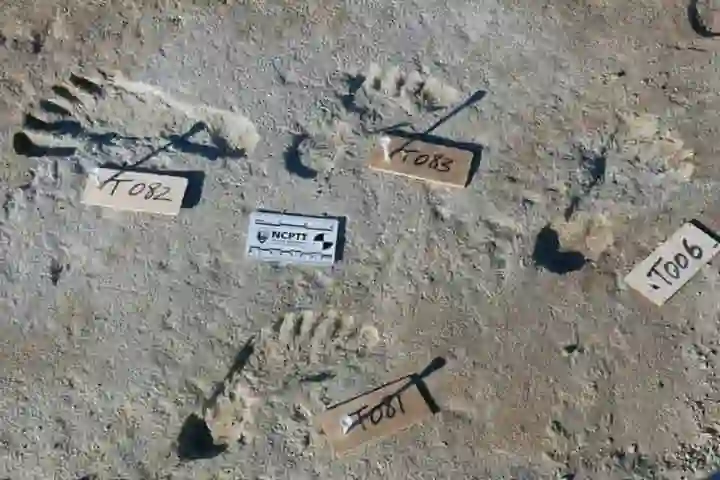Scientists have got conclusive proof of the presence of human beings in North America quite long before the last Ice Age. This came across through the analysis of fossilised footprints at White Sands National Monument in New Mexico.
Published in the journal Science, the research and its findings put the date of the prints between 21,000 and 23,000 years ago, according to an article in smithsonianmag.com.
Co-author of the study David Bustos told NBC News: “We’d been suspicious of the age for a while, and so now [that] we finally have that it’s really exciting. One of the neat things is that you can see mammoth prints in the layers a meter or so above the human footprints, so that just helps to confirm the whole story.”
Bustos is White Sands’ chief of natural and cultural resources.
While these footprints were known to the scientists for long, the new study is the first to date them clearly to such an early period. The date was determined by the researchers by radiocarbon dating of dried ditchgrass seeds which were discovered in layers both above and below the impressions.
Incidentally, these prints are called “ghost prints” as they are visible only under particular weather conditions.
Commenting on the footprints, Tom Higham, a University of Vienna archaeologist, who was not involved in the study remarked: “The evidence is very convincing and extremely exciting. I am convinced that these footprints genuinely are of the age claimed.”
The start of human life in America has been pegged by many archaeologists towards the end of the Ice Age, that is around 13,000 years ago. This was the period when some of the oldest known tools appeared and these were created by the Clovis culture in today’s New Mexico. The hunter-gatherers crossed the land bridge from Siberia to Alaska which became possible as ice sheets melted with the world warming up.
Many archaeological works since the 1970s suggest the arrival of human beings even earlier – somewhere between 16,000 and 17,000 years ago. This took place by traveling down Pacific Coast routes that became navigable even while the interior of the continent was still icy, states National Geographic’s Maya Wei-Haas.
Also read: Pre-Hispanic civilisation pictogram reported about 12 earthquakes in Mexico and Central America
This apart, there is published evidence of even much earlier human presence in North America than this and it includes stone tools that have been dated 30,000 years. This has been questioned by many as they wonder if the tools were really shaped by humans and if the age estimates are correct.
The new White Sands research is different because the prints were obviously made by people, says study Co-author Vance Holiday, a University of Arizona archaeologist and geologist.
Talking to National Geographic, he said: “It’s just screamingly obvious.”
Archaeologist Ciprian Ardelean of Mexico’s Autonomous University of Zacatecas feels the study provides definitive support that at the height of the Ice Age, humans lived in North America. “I think this is probably the biggest discovery about the peopling of America in a hundred years. I don’t know what gods they prayed to, but this is a dream find.”
Also read: A 3,700-year-old Babylonian clay tablet shows masterly use of Applied Geometry!
Other experts are not still not fully convinced. Oregon State University’s archaeologist Loren Davis feels that the radiocarbon dating can’t be relied upon unless there is a second dating method. The reason given is that researchers used aquatic plants for dating and these can pick up “old” carbon from nearby materials. This is known as the freshwater reservoir effect – tending to give a false impression that the plant material is older than it truly is.
The study researchers said this has been taken care of. The team, according to Nature, has dated hundreds of seeds from different layers.
The resulting radiocarbon dating was in line with their place in the geological record. Thus the older seeds were on the bottom, while on the top were the younger ones.
Significantly the new dating places the humans in the same time period when huge animals like mammoths, giant sloths and direwolves were there, according to the study’s co-author Sally Reynolds, a palaeontologist at Bournemouth University.
Also read: Ethiopian Artefacts looted by the British to Return Home Soon
Explaining this aspect on a video, she said: “It may well be that the humans were harvesting these megafauna as part of their killing and their hunting more sustainably in the earlier years, and potentially through time, as the populations grew, the balance of power shifted and the humans started perhaps overharvesting these megafauna.”
Following this study, a moot question crops up: What became of North America’s Ice Age inhabitants remains? Geneticist at the University of Cambridge, Andrea Manica told BBC News, that clear evidence is in place of modern Native Americans’ ancestors splitting from Asian populations 15,000 to 16,000 years ago. “This would suggest that the initial colonists of the Americas were replaced when the ice corridor formed and another wave of colonists came in. We have no idea how that happened,” he said.




















